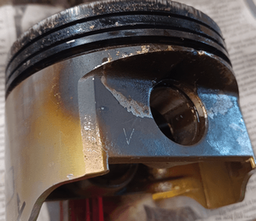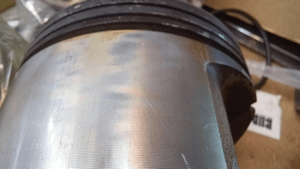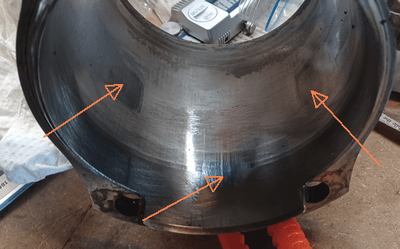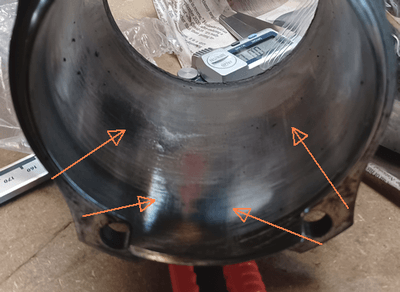-
Posts
3,464 -
Joined
-
Last visited
-
Days Won
47
Content Type
Profiles
Forums
Gallery
Downloads
Blogs
Events
Store
Aircraft
Resources
Tutorials
Articles
Classifieds
Movies
Books
Community Map
Quizzes
Videos Directory
Everything posted by RFguy
-
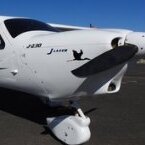
2nd piston ring always stuck- what's the story ?
RFguy replied to RFguy's topic in Engines and Props
-

2nd piston ring always stuck- what's the story ?
RFguy replied to RFguy's topic in Engines and Props
-

2nd piston ring always stuck- what's the story ?
RFguy replied to RFguy's topic in Engines and Props
Turbs the rear leakdowns were 75/80. The front ones < 50 . mid ones, ~ 65. That's according to the book.... (not mine) CYL1, CYL 2 mid ring were jammed stuck. However ! I did find stuckish mid rings and also top rings on all cylinders. ---Bear in mind this engine had been sitting around under a bench in a workshop for a year before I got it, so plenty of ring lands and rings had a chance to go hard and stick even if they were not at last flight. -
It is I think, for training purposes, as excellent real genuine clear easy to see video sequence of ... what happens when airspeed drops too far for the maneuver (S&L or banked) We all do it up at 5000' . and ab-initio , dont think there is internal from the cockpit appreciation of what the plane is doing.
-
I thought it was a airport re development. Either way, I think we can say not an aiport fault... and are we sure that video is legit and authentic and is the aircraft ? Did the engines not respond to command for thrust (RPM, pitch) and the pilots try and 'extend the glide ' ???? Pilots who fly these dont fall for the downwind landing and ground speed illusion error. The airplane is doing half the checks for them . (and screamign)
-
well that's a wing drop if I ever saw one.
-

2nd piston ring always stuck- what's the story ?
RFguy replied to RFguy's topic in Engines and Props
that's an engine I got used, 320h TSO, latest Gen3. I assume it went through the usual process. I have simply pulled it apart to think about it. -

2nd piston ring always stuck- what's the story ?
RFguy replied to RFguy's topic in Engines and Props
Well that is an interesting point Nev- the stress with power down between top and skirt. The two instances I have personally been told about, not 2nd hand, the pilot and plane at WOT was at top of circuit climb, had done or was about to reduce power , and high RPM.. (exact timing not known or remember) ......... Other people have reported go around breakages, which is a hard one on the engine if power applied 'instantly' to chilled bores. I am used to watching the local school' Pipers engine stop and prop rock at shutdown. My previous 3300 did rock at shutdown, but then after 1 or 2 minutes became tighter... The older engines tend to rock and not get so tight I am told. -

2nd piston ring always stuck- what's the story ?
RFguy replied to RFguy's topic in Engines and Props
Jabs rarely bounce off compression. when stopped (after run) , they're usualy tight. There is conjecture about this whether it is pistons tight in the cylinders or crankcases goign out of alignment. Jab bores are plain cro-mo. Onetrack- certainly the cast Jab pistons are shaped . In research Ive come across about 6 different 'webbing's under the piston crown each requiring their own ovality type and characteristics so that they are round when hot..... It's quite a science and likely an equal amount of testing that results in cylinders that are worse for wear and unhappy pistons. -

2nd piston ring always stuck- what's the story ?
RFguy replied to RFguy's topic in Engines and Props
well, these bores wont be refurbished by me with my long hone stone tool at home , it will be a shop most likely that does this stuff. We'll see how the measurements with the new micrometer come out when it arrives. comes back to my mantra of that jab engine should not fly if leakdowns are < 65/80 because the engines cannot tolerate the ills..... ( unless you really know what you are doing). Flying with low leakdowns in a Jab is a bad idea IMO because the engine cannot tolerate the ills that occur because of all the many reasons bad leakdowns are occurring. . Lycos seems to have enough in hand with design and materials to put up with poor condition without breaking. If I put the pistons back in, its likely they'd be OK since this engine didnt yet break and I am not hamfisted with power application. And jabs dont go bang very often. Still plenty to learn. Set of Mahles (x6) and rings (x6) is only $800 aussie....one could argue that would be a better use of my time but until I understand everyhting, that's too much of a experiment to run. -

2nd piston ring always stuck- what's the story ?
RFguy replied to RFguy's topic in Engines and Props
HI Nev. it's not uncommon either..... The Mahle 4032 forged piston is a option. the dish CC is about the same, compression height is about 0.8mm higher than the jab piston which puts compression up from 8:! to 8.6 ish. exactly how tight it gets between head and top of piston at full smoke I dunno yet. (check) . uses round wire clip I think. This is not a split skirt of course, and my guess is that the skirt will be narrower because it cops more crown heat But before I go swapping pistons I want to know ... everything. (These pistons are used by others in jabs with varying mods...) The bore region mid depth (the four points) if they show more than 0.01mm out that'll be no good for ring seal. (Jab limit in book is 0.02mm) (I have ordered a really good bore micrometer to improve on my crappy one) . The lowest regions of wear where the skirt is with piston at BDC - I can feel the wear depth with my finger. I'll likely get a honing shop to overbore them out to get back to round at the 4 pointsd in the middle IE only about half a thou (IF HALF A thou is what is required to get round) . I will need to consult gurus. IE I would consider half a thou mid way, then maybe 7 tenths of a thou at the bottom. Dont think I need to touch the top, ALTHOUGH going to Liquid heads from air cooled heads takes 50 deg C off the top inch, so perhaps take the half though down to 2/3 depth, then 7tenths thou from there. Still all miiles and miles within the (quite wide) Jab tols. (or lyco for that matter) . Different to the tols on track racing vehicles I observe. I think there IS a problem with the lack of taper in the cylinder i think . There are many with hourglass shapes. . hot in the middle, colder at the ends, and so narrowerin the middle , wider at the ends- is fairly common for air cooled cylinder bores it seems. -

2nd piston ring always stuck- what's the story ?
RFguy replied to RFguy's topic in Engines and Props
#5 piston. step crown thermal application shows same distribution as that colouring ! There is negligible scuffing /marking of the bores at the back cylinders , the unhappy bores are the pair at the front- the air blast cooled bores... #1 piston. (has ben through the MEK) BORE 1 - LOWER BORE 1 UPPER -

2nd piston ring always stuck- what's the story ?
RFguy replied to RFguy's topic in Engines and Props
Nev this is removed cylinder material . I wont repeat the whole thing here . (croMo bores) To these slotted pistons. I did some thermal analysis and step heat appication (heat applied to the crown) with a thermal camera to the jab pistons to verify my analysis/ and I measured the hell out of them in and out of an oven to verify my suspicions. The skirt is max diameter, makes for peace and quiet . now that's fine if you consider the heat cant get across the slot to heat the skirt, BUT given sustained power input, the heat soaks through the (large) pin bosses and gets around into those classic four points. So, vehicles that WOT for 10 seconds might be fine. That location is is when the piston is travel half way between BDC and TDC. The air cooled bores also have their own temperature profile. cold at the bottom. the bores also show inteference between the centreline of the skirts and the bore region with the piston at BDC (cold region). If the skirts get within 50 deg C of crown temp, they'll likely interfere down there. The $64 question is is the material removed because the rings stuck and then lubrication was not as good (blow by), (IE it tolerated the intereference UNTIL the lubrication suffered due to rings sticking and blowing off/cooking the oil film) or did the material from the interference get in the ring lands and THEN they stuck. ???? -

2nd piston ring always stuck- what's the story ?
RFguy replied to RFguy's topic in Engines and Props
Bosi - these are 300 hour pistons. you'll need to read the first few posts in this thread to get context., Nev- "I really think you're barking up the wrong tree here. Split skirt pistons are no good in air-cooled motors" ----But that's what the Silvolite jab pistons are in Gen 3. Anyway, I just wanted an opinion from (perhaps vehicle) engine builders to whether the removed material from half way down the cylinder (during an interference situation) gets swept up in the the 2nd ring land, and that is perhaps the propensity to stick the middle rings. (but them you'd expect the top ring to sweep up the burned oil on the way back up the TDC) I've been learning all about pistons, shapes, alloys , expansion control techniques, heat control techniques, shaped cylinder bores, ring designs and techniques... etc etc etc. (Bruce micrometer yes- most jab engines are like this) -

2nd piston ring always stuck- what's the story ?
RFguy replied to RFguy's topic in Engines and Props
So.... IF there is material being removed from the cylinder wall, (removed by contact with the skirt region on the four sides of the skirts next to the piston pin bosses (these are split skirt)) - IE the four point wear is visible at 50% of the stroke distance so the rings do pass it- and if the material is removed/conact on the power stroke (down) .. then... Will it be the 2nd ring region that scoops up the material ??? and thus assist caking/choking or even welding up the ring lands /rings ??? -
Mark, where do you buy those manifolds ?, PN ?
-
20 hours and no solo might be OK, depends on age stats are something like 30 minutes longer to go solo for each year over 25.....
-
My first solo- I was more relaxed without the instructor present. Flying the circuit in the last hour of the day in still air it was an easy job. And in LSA we all remember how the airplane climbs like a scalded cat without the instructor in the other seat ! Like "Holy sh1t I'm already at 500' and still over the runway "
-
IMO the POWERMATE regulator is overhyped- you get abotu half the maximum delivery of the alternator, what it is actually is a current and voltage regulator. I would not recommend it. All the Kubota regulators are pretty much the same. Be sure to mount it somewhere it gets an air blast at all times. Firstly, with the regulator : *Again, it needs to be stressed that the wiring PATH is just as important than the regulator type.* 1) Sense wire- direct to battery via fuse. might need a slave relay from master if draws any current when doing nothing. 2) charge output wire- direct to battery via slave relay from master via 25A fuse. 3) negative return . direct to battery go PAST / VIA the negative of the smoothing cap. 4) alternator - direct---- fuses not necessary if charge output has a fuse. Useful - 10,000uF, 50V capacitor between output of charge output of regulator and the negative . The cap is useful because some fuel senders and sensors do not like the high ripple power that the alternator delivers in the system- it fixes that.. SECOND If the flywheel protection diode is not present across the master relay then whenever you turn the master off you will put a huge spike through the system. A unidirectional TVS diode is a good option across the master bus. It is a good idea to fuse it say 1 to 5 A. Suggest a TVS type 1.5ke18a, https://au.rs-online.com/web/p/tvs-diodes/4864195 these are hard to get right now , suggest grab a couple. remember BAND END to positive side.
-
Thruster88 should know, he's got ag sprayers with hundred of jets. I can see the 2-3 lph being useful for a hot conditions idle RPM taxi down to the end of the runway before TO roll. Minimal flow rates present and airplane not into the wind. aux fuel pump on to push up line pressure should deal with most heat issues. (aside from carb float bowl overflowing which is a IMO a real fire risk with the rotax carb locations without overflow pipes and heat shields. )
-
I think 2-3 lph is a minimum. Carb use is 6-30 lph For other's benefit... for 6mm ID hose, that's a volume of 28mL per meter of hose AT 2 lph (0.555mL/second) it would take about (28mL divided 0.555ml/second ) = 50 seconds to cycle through 1m of hose. At least its moving. Skip, I would bring the T/bleed junction right back as far as possible on the engine. It's hot amongst the water plumbing on top of the crank case...
-
and I beleive that the fuel returns for the rotax need to go from T jets at the carburettor fuel inputs, not at the fuel pump output ... the fuel pump gets a good air blast, but it can be pretty damn hot in the fuel line running over the top of the engine which is very crowded and hot. hence the returns at the carbs. Also, the float bowls need heat shields. (IMO) many aircraft have drip trays under the carbs which function well as shields. I would always have the fuel overflow/etc pipe not drip into the tray like some aircraft I see with a drain pipe on the drain . jesus no, needs to go out in a pipe away from the exhaust pipe. otherwise just what you need a drip tray full of fuel !
-

Fuel flow sender/sensor options
RFguy replied to trailer's topic in Instruments, Radios and Electronics
It's a check to understand / know the engine output / workload, along with MAP. RPM and throttle position might mean nothing without MAP and fuel flow.







